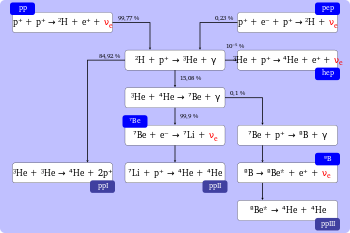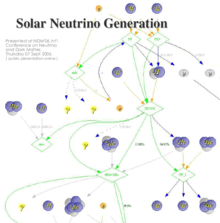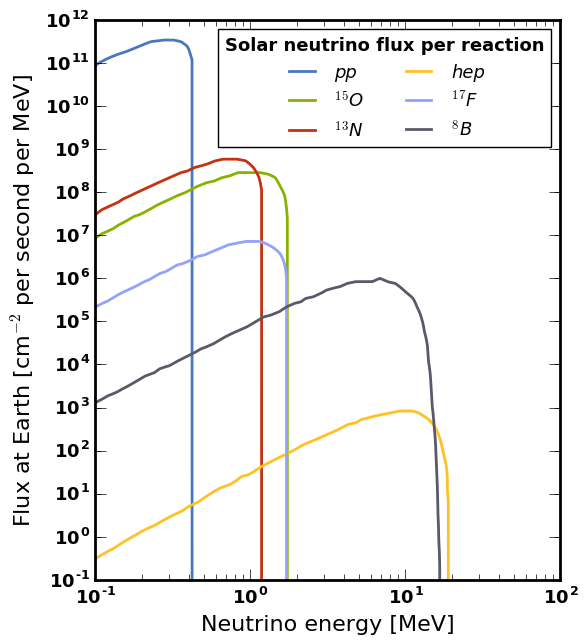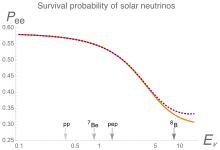Solar neutrino

Electron neutrinos are produced in the Sun as a product of nuclear fusion. Solar neutrinos constitute by far the largest flux of neutrinos from natural sources observed on Earth, as compared with e.g. atmospheric neutrinos or the diffuse supernova neutrino background.[1]
Production mechanisms

Solar neutrinos are produced in the core of the sun through various nuclear fusion reactions, each of which occurs at a particular rate and leads to its own spectrum of neutrinos. Details of these reactions are listed below.
The main contribution comes from the proton-proton reaction. The reaction is:
or in words:
- 2 protons deuteron + positron + electron neutrino.
From this reaction, 86% of all solar neutrinos are produced. As seen in figure, Solar neutrinos (proton-proton chain) in the Standard Solar Model, the deuteron will fuse with another proton to create a 3He nucleus and a gamma ray. This reaction can be seen as:
The isotope 4He can be produced by using the 3He in the previous reaction which is seen below.
With both helium-3 and helium-4 in the system now, beryllium can be fused by the reaction of one of each helium nucleus as seen in the reaction:
Since there are four protons and only three neutrons, the beryllium can go down two different paths from here. The beryllium could capture an electron and produce a lithium-7 nucleus and an electron neutrino. It can also capture a proton due to the abundance in a star. This will create boron-8. Both these reactions are seen respectively below:
This reaction produces 14% of the solar neutrinos. The lithium-7 will combine with a proton to produce 2 nuclei of helium-4.
The boron-8 will beta(+) decay into beryllium-8 due to the extra proton which can be seen below:
The reaction produces about 0.02% of the solar neutrinos. These few solar neutrinos have the larger energies. The asterisk on beryllium-8 indicates that the nucleus is in an excited state.[2]
The excited beryllium-8 nucleus then splits into two helium-4 nuclei.
Observed data

The highest flux of solar neutrinos come directly from the proton-proton interaction, and have a low energy, up to 400 keV, as shown in Fig. 1. There are also several other significant production mechanisms, with energies up to 18 MeV.[3] From the Earth, the amount of neutrino flux at Earth is around 7·1010 particles·cm−2·s −1.[4] The number of neutrinos can be predicted by the Standard Solar Model. The detected number of electron neutrinos was only 1/3 of the predicted number, and this was known as the solar neutrino problem. It led to the idea of neutrino oscillation and the fact that neutrinos can change flavour. This was confirmed when the total flux of solar neutrinos of all types was measured and it agreed with the earlier predictions of expected electron neutrino flux, as seen by Sudbury Neutrino Observatory, and thus confirmed that neutrinos have mass. Solar models additionally predict the location within the Sun's core where solar neutrinos should originate from, depending on the nuclear fusion reaction which leads to their production. Future neutrino detectors will be able to detect the incoming direction of these neutrinos with enough precision to measure this effect.[5]

The energy spectrum of solar neutrinos is also predicted by solar models.[6] It is essential to know this energy spectrum because different neutrino detection experiments are sensitive to different neutrino energy ranges. The Homestake Experiment used chlorine and was most sensitive to solar neutrinos produced by the decay of the beryllium isotope 7Be. The Sudbury Neutrino Observatory is most sensitive to solar neutrinos produced by 8B. The detectors that use gallium are most sensitive to the solar neutrinos produced by the proton-proton chain reaction process, however they were not able to observe this contribution separately. The observation of the neutrinos from the basic reaction of this chain, proton-proton fusion in deuterium, was achieved for the first time by Borexino in 2014. In 2012 the same collaboration reported detecting low-energy neutrinos for the proton-electron-proton (pep reaction) that produces 1 in 400 deuterium nuclei in the sun.[7][8] The detector contained 100 metric tons of liquid and saw on average 3 events each day (due to carbon 11 production) from this relatively uncommon thermonuclear reaction. Note that Borexino measured neutrinos of several energies; in this manner they have demonstrated experimentally, for the first time, the pattern of solar neutrino oscillations predicted by the theory. Neutrinos can trigger nuclear reactions. By looking at ancient ores of various ages that have been exposed to solar neutrinos over geologic time, it may be possible to interrogate the luminosity of the Sun over time,[9] which, according to the Standard Solar Model, has changed with time.
See also
References
- ↑ Billard, J.; Strigari, L.; Figueroa-Feliciano, E. (2014). "Implication of neutrino backgrounds on the reach of next generation dark matter direct detection experiments". Phys. Rev. D. 89 (2): 023524. arXiv:1307.5458. Bibcode:2014PhRvD..89b3524B. doi:10.1103/PhysRevD.89.023524.
- ↑ Grupen, Claus (2005), Astroparticle Physics, Springer, ISBN 978-3-540-25312-9
- ↑ Bellerive, A. (2004), "Review of solar neutrino experiments", Int. J. Mod. Phys. A, 19 (8): 1167–1179, arXiv:hep-ex/0312045, Bibcode:2004IJMPA..19.1167B, doi:10.1142/S0217751X04019093
- ↑ Grupen 2005, p. 95
- ↑ Davis, Jonathan H. (2111). "Projections for Measuring the Size of the Solar Core with Neutrino-Electron Scattering". Physical Review Letters. 117 (21): 211101. arXiv:1606.02558. Bibcode:2016PhRvL.117u1101D. doi:10.1103/PhysRevLett.117.211101. PMID 27911522. Check date values in:
|year=(help) - ↑ Solar Neutrino Viewgraphs
- ↑ Bellini, G.; et al. (2012), "First Evidence of pep Solar Neutrinos by Direct Detection in Borexino", Phys. Rev. Lett., 108 (5): 051302, arXiv:1110.3230 [hep-ex], Bibcode:2012PhRvL.108e1302B, doi:10.1103/PhysRevLett.108.051302, PMID 22400925, 051302 Cite uses deprecated parameter
|class=(help) . 6 pages; preprint on arXiv - ↑ Witze, Alexandra (March 10, 2012), "Elusive solar neutrinos spotted, detection reveals more about reaction that powers sun", Science News, 181 (5): 14, doi:10.1002/scin.5591810516
- ↑ Haxton, W. C. (1990). "Proposed neutrino monitor of long-term solar burning". Physical Review Letters. 65 (7): 809–812. Bibcode:1990PhRvL..65..809H. doi:10.1103/physrevlett.65.809. PMID 10043028.
Further reading
- Haxton, W.C.; Hamish Robertson, R.G.; Serenelli, Aldo M. (18 August 2013). "Solar Neutrinos: Status and Prospects". Annual Review of Astronomy and Astrophysics. 51 (1): 21–61. arXiv:1208.5723. Bibcode:2013ARA&A..51...21H. CiteSeerX 10.1.1.755.6940. doi:10.1146/annurev-astro-081811-125539.